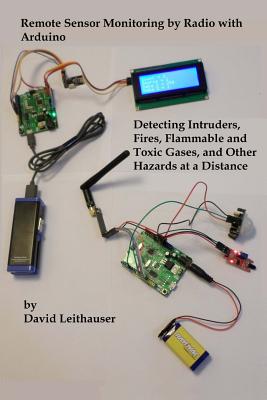Remote Sensor Monitoring by Radio with Arduino: Detecting Intruders, Fires, Flammable and Toxic Gases, and other Hazards at a Distance

Remote Sensor Monitoring by Radio with Arduino: Detecting Intruders, Fires, Flammable and Toxic Gases, and other Hazards at a Distance
This book is about connecting sensors and radio transceivers to an Arduino so that you can monitor the sensor readings from a distance. You can put the Arduino sensor package miles away from the receiving station, in your front or back yard, or even in your home like your basement or attic. Although the techniques described in this book will work with any type of sensor input, the book will focus on sensors that detect potentially dangerous or disruptive conditions. These will include intruders, fires, flammable gas leaks and other toxic gases like pollution, power failures, floods (including minor "floods" like a pipe bursting), and other hazards. For the radio communications, we will use the nRF24L01 transceiver chip. This inexpensive chip (usually around $1.00 on EBay) interfaces easily with the Arduino and can both transmit and receive data. It has an advertised range of 100 meters (about 328 feet) for the basic unit, although in actual practice it may be closer to 30 meters (about 98 feet). However, with an optional antenna the range is reported to be 1,000 meters (1 km, about .6 miles). In the first five chapters, I explain the hardware and software aspects of this handy transceiver, enabling you to set up the communications. I even explain how to set up repeater transmitters that can relay the signal from locations beyond the 1 km range. In the chapters after these five chapters, I discuss attaching and operating various analog and digital sensors, explaining how to set them up and integrate them into the transmission software. The chapters will be divided by hazards you can monitor, not specific sensors, so one chapter may include several different types of sensors that can be used to detect the same hazard.
The main sketches in this book an be downloaded from any of these URLs
https: //github.com/DavidLeithauser/remote-sensors-Arduino/tree/master
http: //LeithauserResearch.com/RemoteSensors.zip
http: //lrfiles.com/RemoteSensors.zip
https: //app.box.com/s/xsf7e6gsof5jteijvcq7zd38cfwcu53r
See the ReadMe.txt file in the archive for advise on using the files.
All of the sketches in this book have been tested and work as described. If you have any problem running them, you can contact the author at Leithauser@aol.com. Please use subject line Remote Sensor book on the email.
PRP: 79.36 Lei
Acesta este Prețul Recomandat de Producător. Prețul de vânzare al produsului este afișat mai jos.
71.42Lei
71.42Lei
79.36 LeiLivrare in 2-4 saptamani
Descrierea produsului
This book is about connecting sensors and radio transceivers to an Arduino so that you can monitor the sensor readings from a distance. You can put the Arduino sensor package miles away from the receiving station, in your front or back yard, or even in your home like your basement or attic. Although the techniques described in this book will work with any type of sensor input, the book will focus on sensors that detect potentially dangerous or disruptive conditions. These will include intruders, fires, flammable gas leaks and other toxic gases like pollution, power failures, floods (including minor "floods" like a pipe bursting), and other hazards. For the radio communications, we will use the nRF24L01 transceiver chip. This inexpensive chip (usually around $1.00 on EBay) interfaces easily with the Arduino and can both transmit and receive data. It has an advertised range of 100 meters (about 328 feet) for the basic unit, although in actual practice it may be closer to 30 meters (about 98 feet). However, with an optional antenna the range is reported to be 1,000 meters (1 km, about .6 miles). In the first five chapters, I explain the hardware and software aspects of this handy transceiver, enabling you to set up the communications. I even explain how to set up repeater transmitters that can relay the signal from locations beyond the 1 km range. In the chapters after these five chapters, I discuss attaching and operating various analog and digital sensors, explaining how to set them up and integrate them into the transmission software. The chapters will be divided by hazards you can monitor, not specific sensors, so one chapter may include several different types of sensors that can be used to detect the same hazard.
The main sketches in this book an be downloaded from any of these URLs
https: //github.com/DavidLeithauser/remote-sensors-Arduino/tree/master
http: //LeithauserResearch.com/RemoteSensors.zip
http: //lrfiles.com/RemoteSensors.zip
https: //app.box.com/s/xsf7e6gsof5jteijvcq7zd38cfwcu53r
See the ReadMe.txt file in the archive for advise on using the files.
All of the sketches in this book have been tested and work as described. If you have any problem running them, you can contact the author at Leithauser@aol.com. Please use subject line Remote Sensor book on the email.
Detaliile produsului










